24 Hours Hotline: +8613735411378
Email:chengdu@tripstoshanghai.com
24 Hours Hotline: +8613735411378
Email:chengdu@tripstoshanghai.com
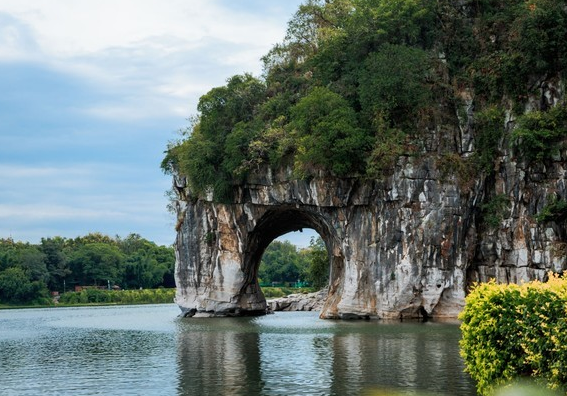
Overview
Guilin enjoys the best landscape under heaven. The city abounds in scenic spots such as Elephant Trunk Hill, the symbol of Guilin's scenery and Reed Flute Cave with stalagmites and stalagmites with striking shapes and colors. The Li River cruise from Guilin to Yangshuo is the centerpiece of any trip to Guilin, with hundreds of hills flanking the emerald water. Cruise among the vivid reflections of scenery on the river while passing the fertile farm lands covered in brocade or veiled in mists. The surrounding counties of Gongcheng, Guanyang, Lingui, Lingchuan, Lipu, Longsheng, Pingle, Quanzhou, Xing'an, Yangshuo, Yongfu and Ziyuan hold many other surprises that will make your visit to Guilin unforgetable.
Top 8 Attractions
Elephant Trunk Hill
The Elephant Trunk Hill is a hill, landmark and tourist attraction in Guilin, Guangxi, China.
Elephant Trunk Hill is the symbol of the city of Guilin. It got its name because it looks like an elephant drinking water. The round opening that would be under the elephant’s trunk is known as Water-Moon Cave because at night the reflection of the moon can be seen through the arch and it looks as if it is under the water and floating on the surface of the water at the same time. Elephant Trunk Hill and Water-Moon Cave are located at the confluence of the Taohua River and the Lijiang River.
Fubo Hill
Fubo Hill (Wave-Subduing Hill), is 120 meters long, 60 meters wide and 213 meters high. It stands solitarily in the northeast of the city and on west bank of Li River with half of the hill stretching into the river. Waves run back wherever they meet the blocks, hence the name "wave-subduing Hill". A tale has it that Ma Yuan who was called General Fubo from the Han Dynasty had once passed by Guilin on a southern expedition. He poured all the pearls he carried into the river, so the hill was named after him in his memory.
On the southern slope of the hill is Pearl-Returning Cave (huangzhu dong). The legend about this cave says that once a fisherman entered the cave and saw an old man sleeping with a pearly by his side. The fisherman stole the pearl and took it home. Someone told him that the pearl belonged to the Dragon king and that he would get angry if the pearl was not return. Hence the cave is called Return the Pearly Cave .
Reed Flute Cave
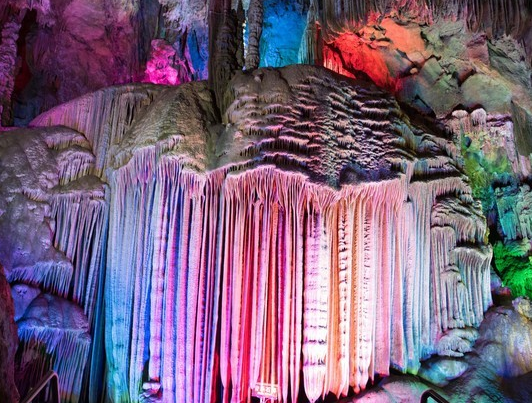
The Reed Flute Cave, also known as "the Palace of Natural Arts” is a landmark and tourist attraction in Guilin, Guangxi, China. It is a natural limestone cave with multicolored lighting and has been one of Guilin’s most interesting attractions for over 1200 years. It is over 180 million years old.
The cave got its name from the type of reed growing outside, which can be made into flutes. Reed Flute Cave is filled with a large number of stalactites, stalagmites and other rock formations. Inside, there are more than 70 inscriptions written in ink, which can be dated back as far as 792 AD in the Tang Dynasty. These aged inscriptions tell us that it has been an attraction in Guilin since ancient times. It was rediscovered in the 1940s by a group of refugees fleeing the Japanese troops. Nowadays, multicolored lighting artificially illuminates the cave.
Folded Brocade Hill
Situated in the northeast of Guilin by the Li River, Folded Brocade Hill (Diecai Hill) is one of the most popular local attractions, a place known for its amazing scenery and stone carvings. It gained its name because of the resemblance of its rock formations, piled up layer upon layer on each other, to folded brocade. Many other special names have been given to this picturesque spot: the name Laurel Hill (Gui Hill), derived from the laurels that have spread across the slopes since ancient times, and the name of Wind Cave Hill, due to the remarkable wind cave on the hill. Four small hills, Yuyue Hill, All-Direction-Looking Hill (Siwang Hill), Crane Peak and Bright Moon Peak surround Folded Brocade Hill.
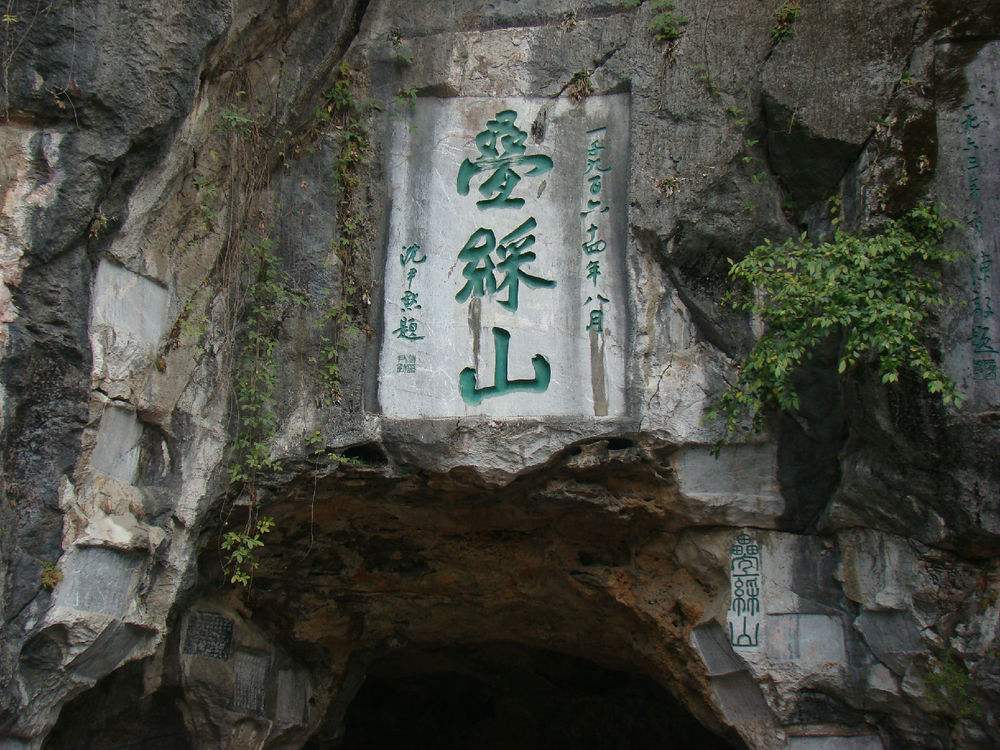
Daxu Ancient Town
Daxu Ancient Town was initially founded during the early Northern Song Dynasty (960-1127 AD), which means it has a history of over one thousand years. It was a prosperous market town at that time thanks to the convenient water transport. And during the period of the Republic of China (1911-1949), the town was in its heyday. There were eight broad commercial streets, more than ten docks, and merchants came together in crowds. It was the leader among the four best known ancient towns in Guangxi in terms of its scale. Now all that prosperity has gone, leaving the town standing quietly by Li River.
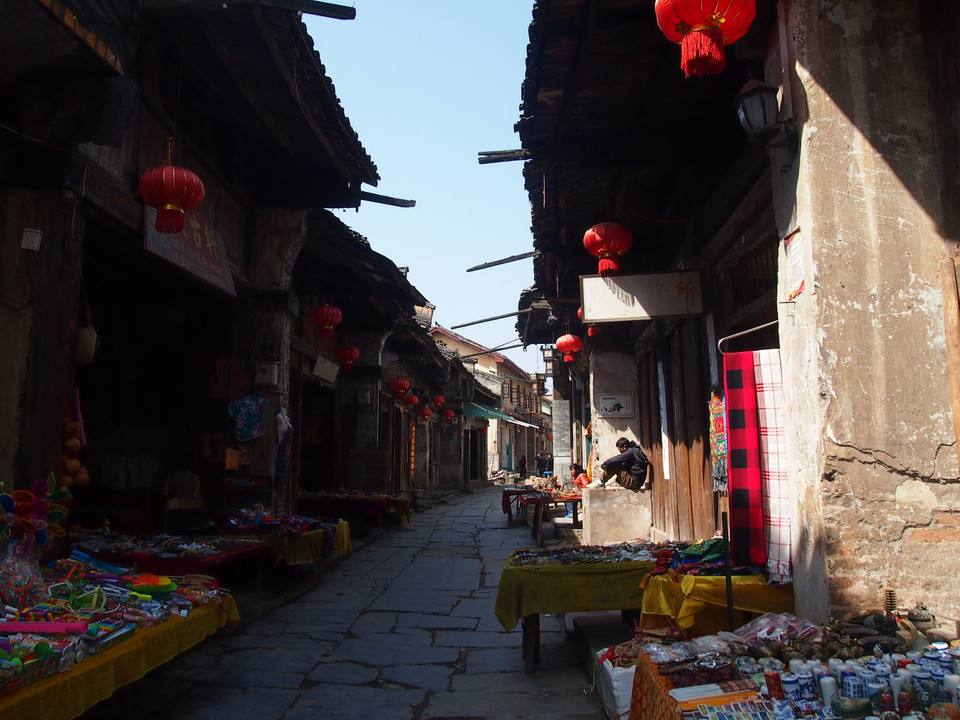
Li River
The Li River or Lijiang is a river in Guilin, Guangxi Zhuang Autonomous Region, China. The Li River Cruise ranges 83 kilometers from Guilin to Yangshuo and is famous for the Karst mountain and river sights. It was selected as one of the world's top 10 watery wonders by America's National Geographic magazine.
The Li River originates in the Mao'er Mountains in Xing'an County and flows in the general southern direction through Guilin, Yangshuo and Pingle. In Pingle the Li River merges with the Lipu River and the Gongcheng River and continues south as the Gui River, which falls into the Xi Jiang, the western tributary of the Pearl River, in Wuzhou.
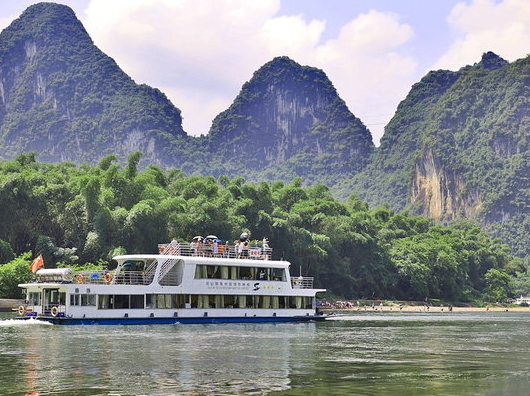
The upper course of the River Li is connected by the ancient Lingqu Canal with the Xiang River, which flows north into the Yangtze; this in the past made the Li and Gui Rivers part of a highly important waterway connecting the Yangtze Valley with the Pearl River Delta.
The 437-kilometer course of the Li and Gui Rivers is flanked by green hills. Cormorant fishing is often associated with the Lijiang (see bird intelligence). Its unusual karst topography hillsides have often been compared to those at Halong Bay, Vietnam.
Tourist cruises in different boats (varying from small bamboo rafts to larger, air-conditioned ships) are offered on the Li River throughout the year and are one of the major attractions of Guilin.
Yulong River
The Yulong River is a small tributary of the larger Li River in Southeastern Guangxi Zhuang Autonomous Region that runs through the major city of Guilin to Yangshuo. The Yulong starts in Northern Yangshuo County near Litang and runs for over 35 kilometres (22 mi) through small villages of the Yulong River Valley, including Litang, Chaolong, Yima and Gaotian town, before emptying into the Li around the town of Ping Le. The Yulong is a shallow river of around 5 meters (16 ft) maximum depth and an average of 25 meters (82 ft) across. As it is not located near any industrial areas, it is clean enough for swimming, though some brownish surface foam is visible in eddys, probably the result of phosphate runoff from local villages.
Unlike the busy Li River, it has no motorized boat traffic and relies completely on bamboo rafts to ferry passengers downriver. This has become a popular tourist activity, with passengers beginning their journey at the Yulong Bridge, a 400-year-old stone bridge. As the local government has improved local roads through the Yulong River Valley, biking has also become a popular tourist activity, as there are many quaint villages along the river, some offering bed and breakfast accommodation.
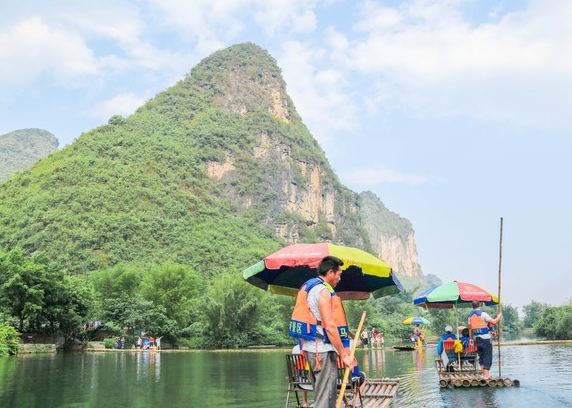
Longji Terraced Field
The Longsheng Rice Terraces(Dragon's Backbone), also called the Longji Rice Terraces, are located in Longsheng County, about 100 kilometres (62 mi) from Guilin, Guangxi, China.
The terraced fields are built along the slope winding from the riverside up to the mountain top, between 600 to 800 metres (2,000 to 2,600 ft) above sea level. A coiling terrace line that starts from the mountain foot up to the mountain top divides the mountain into layers of water in spring, layers of green rice shoots in summer, layers of rice in fall, and layers of frost in winter. The terraced fields were mostly built about 650 years ago.
Longji (Dragon's Backbone) Terraced Rice Fields received their name because the rice terraces resemble a dragon's scales, while the summit of the mountain range looks like the backbone of the dragon.
In early June, water is pumped over the rice paddies and young plants are transferred to the main terraces.
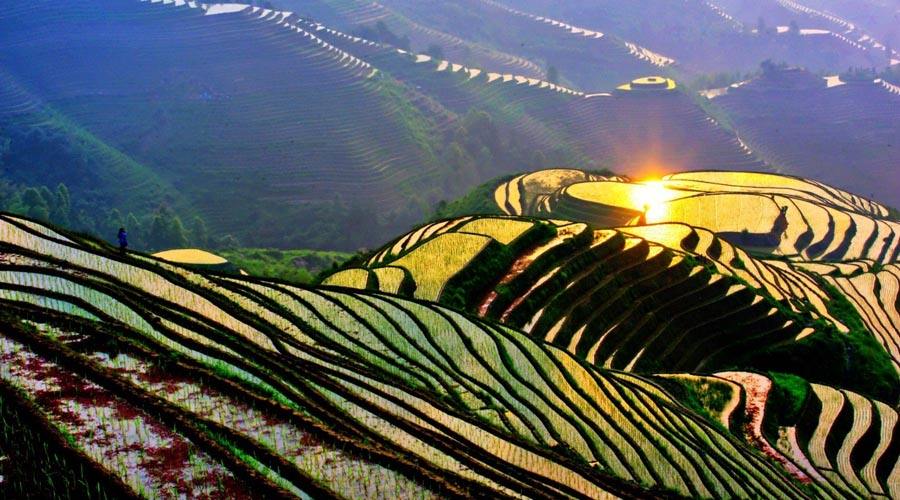
Big Banyan Tree
The Dodda Aalada Mara(????? ??? ??), literally translated to Big Banyan Tree, is a giant 400-year-old banyan tree (Ficus benghalensis), located in the village of Kethohalli in the Bangalore Urban district of Karnataka, India. This single plant covers 3 acres (12,000 m2) and is one of the largest of its kind. In the 2000s, the main root of the tree succumbed to natural disease, and thus the tree now looks like many different trees.
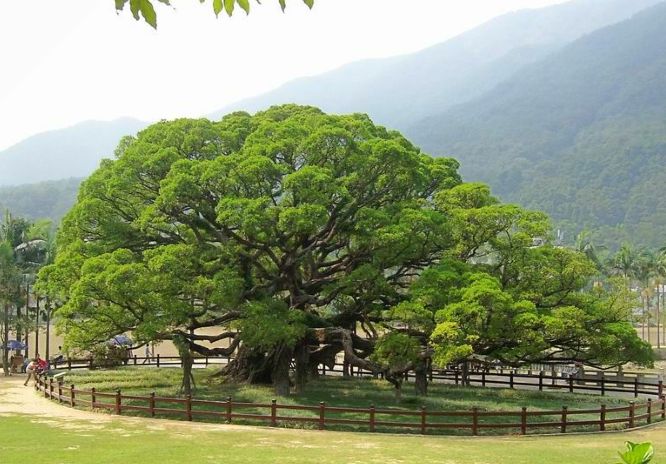
Seven Star Park
Seven Star Park (Qi xing Gongyuan), is located on the eastern side of the Li River, 1 kilometer from the city center. Deriving its name from a cave called Seven-Star Cave. Seven-Star Park covers an area of 40 hectares. Being the largest comprehensive and most beautiful park in Guilin , it features fantastic hills, rivers, caves and rocks. Located in the center, Seven-Star Hill consists of Putuo Hill with four peaks and Crescent Hill with three peaks. The southern entrance straddles the ancient Floral Bridge . Dragon Retreat Cave near the southern gate houses great numbers of stone tablets.
This delightful park that has been landscaped to encompass hills and natural waterways is a great favorite with the local people and tourists alike. At the end of Jiefang Donglu ( Jiefang Road, East ) and approximately one kilometer from the downtown. Seven Star Park got its name from the seven peaks that are supposed to resemble the star pattern of the Big Dipper constellation nearby - four peaks in the north are called Putuo Hill, three in the south are called Lunar Hill. The famous Seven Star cave is located at the Putuo Hill.
Prev: Guilin Shopping
Next: No next link
Wechat: Chinaprivatetour
24 Hours Hotline:
+8613735411378
1 to 1 tailor-made service from our professional travel advisors for the most sophisticated
Constantly excellent reviews for attraction, hotel and service Competitive price
Local experts provide quality tours Best selected knowledgeable local guides Authentic local restaurants
7*24 hours available to create you a worry-free tour. No Hidden Fees and absolutely no pressure to buy. Secured







